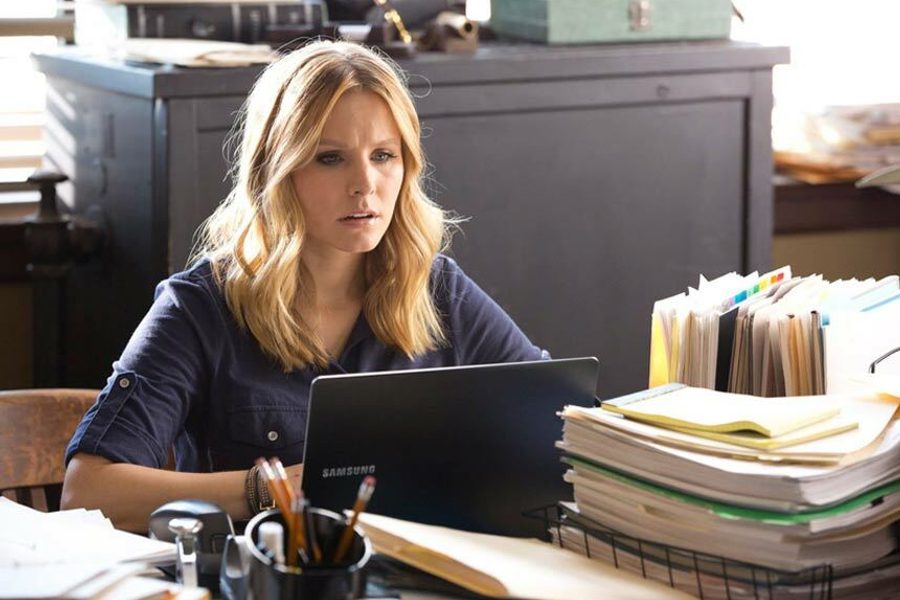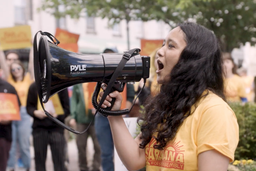Veronica Mars and the Case of the Disappearing Feminism
The movie version of Veronica Mars keeps the wit, but not the politics that once made the TV series great.
Jude Ellison Sady Doyle

It feels cruel to nitpick the Veronica Mars movie. Its very existence is a heartwarming success story: A cult-hit teen drama, cut down in its prime, is resurrected seven years later due to fan interest and a $5.7 million Kickstarter campaign.
And the result is, predictably, $5.7 million worth of fan-service: A long, rambling, star-cameo-crammed excuse for fans to revisit their favorite characters and learn how their lives turned out. If that requires two separate high-school-reunion dance sequences that serve no more purpose than to update us on the life choices of queen-bee Madison (Amanda Noret) and misunderstood motorcycle-gang member Weevil (Francis Capra), so be it. If it requires a two-minute scene constructed entirely to wedge James Franco into the movie, hey, that’s how these things go. If the movie feels like a two-hour-long Veronica Mars episode designed to wrap up hanging plot threads from the series finale, well, that’s exactly what Veronica Mars fans were asking for when they gave Rob Thomas their money. So who are we to complain?
I am going to complain anyway, albeit gingerly. For I am a former Veronica Mars superfan, drawn to the show not only by its noir atmosphere and crackling dialogue, but by its surprisingly progressive and girl-friendly premise: A teenage girl becomes a private eye to battle the classism and rape culture of her hometown. But for me, the core appeal of Veronica Mars ended long before the show did, when showrunner Rob Thomas chose to muddy, dilute, or just plain disavow the show’s initial feminism. Unfortunately, Thomas’ movie version continues this downward trend.
But before I rain all over your parade, let’s pause to remember the good times — namely, the first season of Veronica Mars, which, despite its unlikely Mean Girls Noir take on teen drama, is one of the best single seasons of TV I can name. The story starts thusly: Veronica Mars is a teenage girl, living in the economically divided town of Neptune, California. Half of the town is populated by celebrities and dot-com billionaires; the other half struggles to make ends meet. And, in what was probably the show’s most implausible plot twist, the teenagers of Neptune all attend the same public high school. Veronica is a former popular girl — not wealthy but nevertheless accepted by the rich students because of her father’s position as the town sheriff — whose best friend, a wealthy girl named Lilly Kane, has been murdered. Veronica’s father lost his job after accusing the wrong wealthy man of Lilly’s murder; the Mars family lost what little money they had; Veronica became a social outcast, drubbed out of the clique so viciously that Veronica was drugged and raped at a party hosted by her former friends. Oh, and somewhere in the middle of all this, Veronica’s father became a private investigator, and Veronica joined the family business. The two cases she most longs to crack: Her friend’s murder, and her own rape.
Class war, a commentary on rape culture, and one girl’s quest to avenge another: What, I ask you, was not to love? Add in Kristin Bell’s fantastic performance as Veronica — the woman does hard-bitten like no one’s business, and can wrap her mouth around ridiculously wordy one-liners like “our tantric love-making is remarkable for its stillness and tranquility” without breaking a sweat — and you had what seemed to be one of the all-time greats of pro-feminist TV. Veronica had been victimized, but she wasn’t a victim; she was tough and assertive, without ever being a two-dimensional ice queen or straw feminist; she had agency, intelligence, wit, a firm grasp of class politics, and a rage against the machine (particularly the sexist, lady-victimizing parts thereof) that seemed poised to make her a fantastic role model for girls everywhere.
And then came Logan Echolls (Jason Dohring). Initially, he’s introduced as everything that was wrong with Neptune — a billionaire’s son and “psychopathic jackass” who spouts racist, classist and sexist insults, torments Veronica, and makes homeless people fight each other for his own personal amusement. Dohring got the role by playing his audition scenes with Bell “as if I had raped her.” Then he becomes, for reasons unknown to God or man, Veronica’s main love interest in the series. His bigotry and outbursts of random violence are quickly excused with a story about his abusive upbringing, planting him firmly inside an ancient (and objectionable) tormented-bad-boy archetype. And Veronica Mars became one more story informing girls that it doesn’t matter if your boyfriend is a bigot who frequently erupts into violent rages and occasionally spends a whole year of his life inflicting harassment and emotional abuse upon your person, because he’s, like, really sad inside.
As Logan began to pull more and more of the show’s screen time, actual marginalized people began to slip out of focus. Weevil, the working-class Latino biker with a heart of gold, had practically disappeared from the show by the third season: His only plot lines were about the doomed quest to find him a plot line. Veronica’s “best friend,” Wallace — a boy she found taped to a flag pole in the pilot, who had the dubious distinction of being the show’s only major black character — wanders off into the background, at some point, and never quite finds his way back. As for female characters, well: Outside of the very dead Lilly Kane, it would be hard to find a woman that Veronica actually likes, let alone spent time with. They all seemed to be bitches (Madison the queen bee, Kendall the “gold-digger”), victims (Meg the coma patient, Parker the shaven-headed rape survivor, Lilly Kane), or ditzes (stream-of-consciousness-spouting motormouth Gia Goodman, Madison again). The only ray of light comes in the form of “Mac” Mackenzie, a computer hacker and sort of Willow Rosenberg Lite, who occasionally pops in to help Veronica with computer-related problems. By the end of Season Three, the show’s gender politics reversed themselves so entirely that Veronica’s main antagonists actually included a group of “campus feminists,” portrayed as uniformly humorless, unkempt, strident women who sexually assaulted unconscious men in order to make a political point. Meanwhile, Dick Casablancas (Ryan Hansen) — an attempted rapist who accidentally drugged Veronica Mars — was a beloved fan favorite who seemed to get all the good lines.
Veronica Mars: The Movie is a chance to correct course. But, rather than doing so, it dives headfirst into the black hole that is the Veronica/Logan relationship, from whence no light nor screen time for other characters can escape. Logan has been accused of murdering his girlfriend — not for the first time, which would seem to say something about his desirability as a partner; nearly every woman to see this man naked has wound up dead — and Veronica is determined to rescue him by finding the real killer. In order to do this, she gives up on years of law school, a job at a top New York firm, a stable relationship with a man who adores her, and more or less all of her stated life goals. The show works in some witty commentary about self-destructiveness and people repeating their bad habits — Veronica compares her attraction to Neptune and/or Logan to an addict’s inability to resist a fix — but it’s hard to ignore what’s happening here. This movie is the story of how Veronica Mars, Feminist Role Model, threw away her career for a boy.
As for the rest of the characters — and the greater context of class inequality and discrimination that Veronica Mars once seemed exceptionally smart about tackling — well, they’re mostly ditched in favor of the relationship stuff. Wallace, Weevil and Mac get cameo roles that amount to about five minutes of screen time apiece; hardly more time than it takes for Madison to show up and get punched in the mouth by Veronica. There are glimmers of the commentary that once made this show intriguing: Veronica witnesses Neptune’s police department harassing and brutalizing young black men for being in the wrong neighborhood, and Weevil, after having gone straight and started both a business and a family, is shot and framed for attempted carjacking while trying to help the wrong paranoid white lady. But they’re only glimmers, subsumed into the greater quest to heal Logan’s tortured soul. And the female characters outside of Veronica are nothing to brag about: Logan’s girlfriend, a pop star who is also a cheating drug addict and murder victim, fits both the “bitch” and the “victim” slots. For the “ditz,” we spend a little time with an obsessed fan of Logan’s girlfriend. And, for straight-up “bitch,” we’ve apparently settled on poor, ditzy Gia, who eventually also becomes a victim, thus scoring herself a rare win at Veronica Mars Female Character Bingo.
I admit I may be asking too much from this franchise. The dialogue is still impressive and hilarious, spinning out pop culture references and absurdly complicated put-downs at a mile a minute. (Veronica, confronting drunk Canadians at a karaoke bar: “Like you’re the Barenaked Ladies?” Logan: “Shhh. I think they might be.”) The actors — including Dohring, who really isn’t to blame for how logically insupportable his character has become — are still so invested and skilled that they can make the whole thing slickly watchable. Even the James Franco cameo is surprisingly non-irritating. There’s a lot on offer here, and a lot to enjoy. But I can remember when this wasn’t just a slickly watchable, witty, enjoyable story: when it seemed to aim for something much larger, and more challenging, and more admirable. Unfortunately, much like Veronica herself, Veronica Mars has let its ambitions slide. It’s giving the people what they want — and what they paid $5.7 million to see. But it could have, and should have, given us so much more.

I hope you found this article important. Before you leave, I want to ask you to consider supporting our work with a donation. In These Times needs readers like you to help sustain our mission. We don’t depend on—or want—corporate advertising or deep-pocketed billionaires to fund our journalism. We’re supported by you, the reader, so we can focus on covering the issues that matter most to the progressive movement without fear or compromise.
Our work isn’t hidden behind a paywall because of people like you who support our journalism. We want to keep it that way. If you value the work we do and the movements we cover, please consider donating to In These Times.
Jude Ellison Sady Doyle is an In These Times contributing writer. They are the author of Trainwreck: The Women We Love to Hate, Mock, and Fear… and Why (Melville House, 2016) and was the founder of the blog Tiger Beatdown. You can follow them on Twitter at @sadydoyle.







